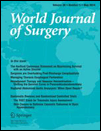Comparison of Perioperative and Long-term Outcomes of Total and Proximal Gastrectomy for Early Gastric Cancer: A Multi-institutional Retrospective Study
Electronic supplementary material: The online version of this article (doi:10.1007/s00268-013-2370-5) contains supplementary material, which is available to authorized users.
Abstract
Background
Various surgical procedures are used to treat early gastric cancers in the upper third of the stomach (U-EGCs). However, there is no general agreement regarding the optimal surgical procedure.
Methods
The medical records of 203 patients with U-EGC were collected from 13 institutions. Surgical procedures were classified as Roux-en-Y esophagojejunostomy after total gastrectomy (TG-RY), esophagogastrostomy after proximal gastrectomy (PG-EG), or jejunal interposition after PG (PG-JI). Patient clinical characteristics and perioperative and long-term outcomes were compared among these three groups.
Results
TG-RY, PG-EG, and PG-JI were performed in 122, 49, and 32 patients, respectively. Tumors were larger in TG-RY patients than in PG-EG and PG-JI patients, and undifferentiated-type gastric adenocarcinoma tended to be more frequent in TG-RY than in PG-EG. The operative time was shorter for PG-EG than for PG-JI and TG-RY. Hospital stay and early postoperative complications were not different for the three procedures. With respect to gastrectomy-associated symptoms, a “stuck feeling” and heartburn tended to be more frequent in PG-EG patients, while dumping syndrome and diarrhea were more frequent in TG-RY patients. Post-surgical weight loss was not different among the three groups, however, serum albumin and hemoglobin levels tended to be lower in TG-RY patients.
Conclusion
Three surgical procedures for U-EGC did not result in differences in weight loss, but PG-EG and PG-JI were better than TG-RY according to some nutritional markers. In U-EGC, where patients are expected to have long survival times, PG-EG and PG-JI should be used rather than TG-RY.




